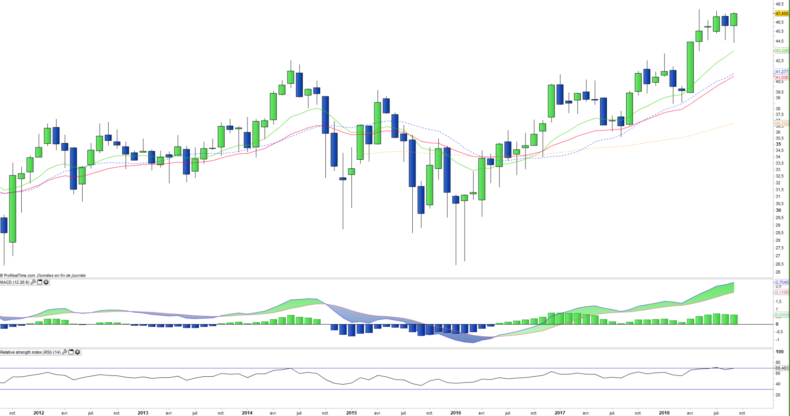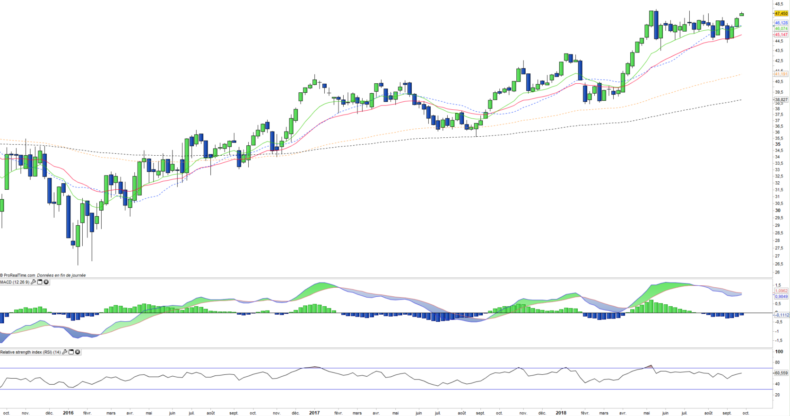Lyxor Stoxx600 Oil & Gas - OIL - 25/09/2018
Short Term strategy: Positive (90%) / Trend +
Long Term strategy: Positive (95%) / Trend +
pour accéder à nos achats / ventes sur les indices
Characteristics of the ETF
The ETF OIL (Lyxor) replicates the Stoxx Europe 600 Oil & Gas Index, which is composed of the main European stocks in the sector. This index is quite concentrated since it has only 22 companies. By geography, the index is mainly exposed to the Euro zone with a weighting of about 31% for France, 15% for the Netherlands and 11% for Italy while the UK weighs c.20%.
The ETF OIL bears a fee of 0.3% with AUM of approximately 314M€. The replication method is indirect (via a swap) and the dividend distribution policy is capitalized.
Alternative ETF: EXH1 (iShares enEuro)
Latest developments
The OIL index has risen by 15.9% since the beginning of the year, outperforming the Stoxx600NR (+ 0.6%), which is linked to the rise in crude prices.
The WTI is on 3-year highs around $ 71, because of the strong global demand and the geopolitical premium which has been restored because of the risks which concern more particularly the opposition between Iran and the Saudi Arabia.
The US unilaterally handed over Iran under embargo while Venezuela's production became very weak. The "investment gap" noted by the cessation of spending by majors since 2014 should also end up weighing on supply, while the growth of shale oil production cannot be extrapolated because of bottlenecks, restrictions and infrastructure problems. Prices should therefore be increasingly dependent on demand in the future.
Major oil majors should continue to benefit from the moderate appreciation of oil prices and accelerate their investments.
Index & components
This oil & gas index is rather concentrated since it contains only 20 stocks that are essentially large market capitalizations, while the top 3 oil majors, which represent 60% of the index, weigh around € 100bn each.
Total (31% of the index), Royal Dutch Shell-A (14%) and BP (14%). The index also includes industrial stocks such as Neste Oil (refining), Technip (engineering) and Vestas (wind power). These values are linked to oil prices, but sometimes in opposite directions (refining is all the more profitable as the price of oil is low and stable), renewable energies are attractive when oil is expensive, while services oil prices are directly correlated to the price of crude and present a risk of increased volatility in a period of uncertainty both in terms of demand and supply.
The current period is characterized by an abundance of supply coming from shale oil, said "unconventional" and which has already caused a significant drop in prices since 2014.
Oil prices are being pulled out of their range because of the geopolitical premium associated with the Middle East crises and the "investment gap" that results from the natural erosion of well productivity in the absence of investment coupled with a strong demand dynamic.
The costs of shale actors tend to drop, but bottlenecks could emerge at a certain level of production, so the short / medium term remains rather bullish. In the longer term, the electric car and the lower consumption of combustion engines should have a deflationary effect on crude prices.
Major oil majors are already investing heavily in oil & shale gas, as well as in renewable energies. They should therefore continue to optimize their asset portfolios in the coming years without significant risk, while oil services players are much more exposed.
Monthly data
The monthly chart shows an upward acceleration of the long-term trend that marks new highs. Oscillators are also on high levels at the edge of overbought situation. The configuration is very positive because the momentum is strengthening for the moment without bullish excess. Prices should continue to rise until a peak is formed that will manifest either in a bullish excess or a shortness of trend.
Weekly data
On the weekly chart, we can observe a bullish restart with the formation of a gap to be confirmed at the end of the week. The trend has been steady since the summer of 2017, with fewer and fewer corrections confirming the strength of the trend. Exceeding the € 48 which corresponds to the peak of last March would confirm the start of a new wave of increase.
ETF Objective
OIL is a UCITS ETF, listed in EUR, which seeks to replicate the STOXX Europe 600 Oil & Gas (Net Return) EUR index (22 companies)
Characteristics
| Inception date | 25/10/2006 |
| Expense ratio | 0,30% |
| Issuer | Lyxor |
| Benchmark | Stoxx 600 Oil & Gas Net Return |
| Ticker | OIL |
| ISIN | FR0010344960 |
| UCITS | Yes |
| EU-SD Status | Out of scope |
| Currency | € |
| Exchange | Euronext Paris |
| Assets Under Management | 315 M€ |
| Dividend | Capitalization |
| PEA (France) | Yes |
| SRD (France) | Yes |
| Number of Holdings | 22 |
| Risk | 4/5 |
Country Breakdown
| France | 30% |
| United Kingdom | 20% |
| Netherlands | 16% |
| Italy | 11% |
| Norway | 7% |
| Spain | 5% |
| Danemark | 3% |
| Others | 8% |
Sector Breakdown
| Energy | 97% |
| Industrials | 3% |
Top Ten Holdings
| Total | 30% |
| Royal Dutch Shell | 15% |
| BP | 15% |
| ENI | 9% |
| Statoil | 5% |
| Repsol | 5% |
| Vestas Wind Systems | 3% |
| TechnipFMC | 3% |
| Snam Spa | 2% |
| Neste Oil | 2% |


